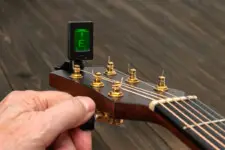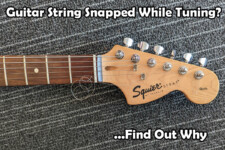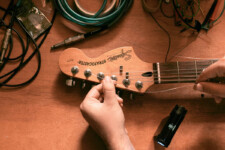Why Does My Electric Guitar Sound Bad? (Fix Your Sound)
A bland sounding guitar can be a frustrating roadblock to overcome on your quest to be a prolific guitarist.
Your guitar can sound bad due to rattling strings, dull tone, or even your guitar sliding out of tune when bending strings. Although the guitar hardware and setup can be to blame, poor playing technique can also cause a guitar to sound bad; such as incorrect finger pressure.
We’re here to break down all of the reasons why your guitar is sounding bad, as well as offer up some surefire ways to fix these problems.
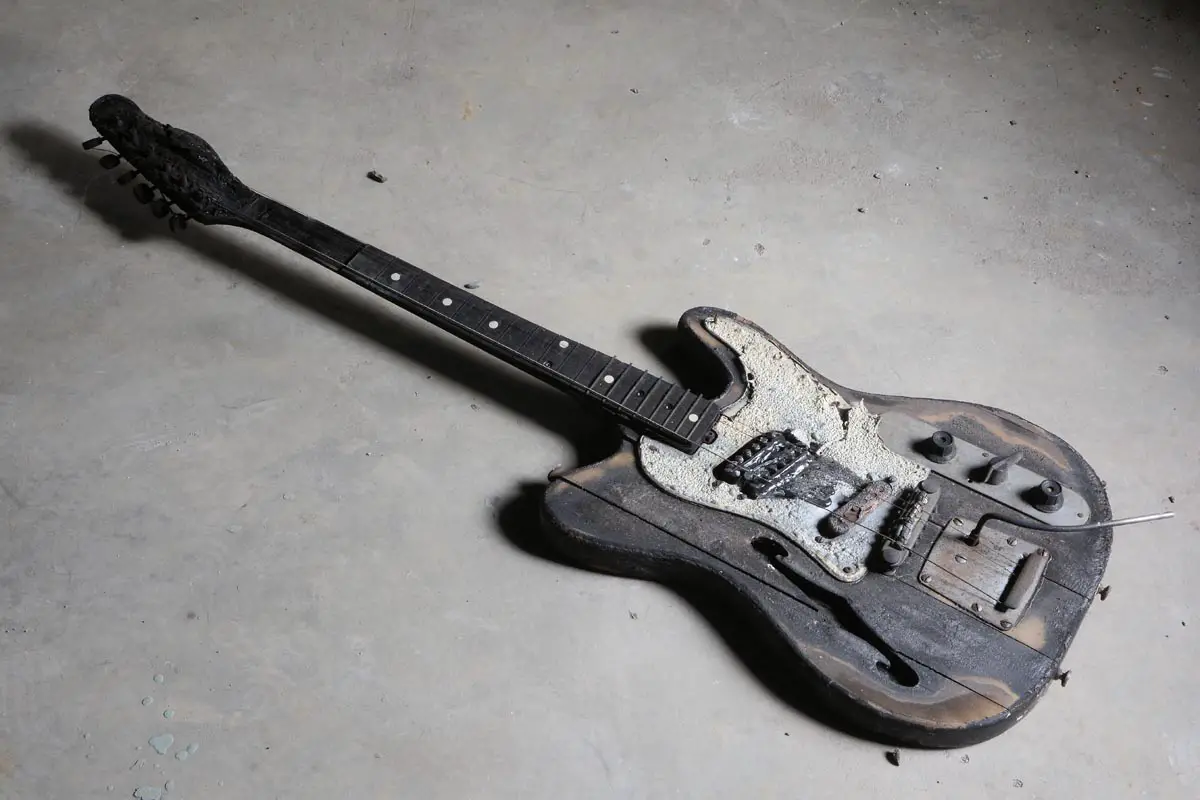
Do All Cheap Electric Guitars Sound Bad?
What makes an electric guitar sound bad has little to do with the price; instead it comes down to the setup of the guitar.
Believe it or not, two of the same guitars, made by the same brand, in the same factory can sound completely different from each other. This comes down to how the guitars are set up during their construction.
Unfortunately, getting a guitar that is set up well or a guitar that is set up poorly is entirely up to chance. With cheap electric guitars there is more chance that some setup work is required after buying them.
Issues that can arise from a poorly setup guitar can have a huge impact on the action of your guitar. For instance, if the strings are too high at the nut, it can cause notes on your lower frets to sound out of tune. If the strings are too low at the nut, this can cause your strings to touch unwanted frets and cause an awful rattling sound as you play.
You would be amazed how some simple setup work can make many cheap electric guitars sound like much more expensive ones.
There are some fantastic sounding guitars you can get on the cheap. Brands to note included Squier, Epiphone, Yamaha, and Ibanez.
Sometimes It’s About Your Technique
Every guitar no matter how alike requires a slightly different technique. Getting to know how to properly play your guitar can help you get the most out of a cheap guitar.
Finger pressure is a big one, particularly when playing bar chords. Make sure each string being played is pressed down firmly so that it makes clean contact with the fretboard.
- If the strings are pressed with too little pressure it will cause notes in your chords to not ring out correctly. It can also cause unwanted rattling that mucks up your chords.
- Conversely, if you play chords and individual notes with too much pressure, you will cause the sound to be a little sharp, and will make your guitar sound out of tune.
Another to watch out for is your strumming technique. Make sure all your finger (except for the ones you’re using to play!) and your palm, are well clear of your strings. Even the slightest touch can ruin the sustain of your strings.
Do I Need to Buy An Expensive Electric Guitar To Sound Good?
There’s no denying that higher build quality and expert setup go a long way to making a guitar sound great.
However, the price of your guitar won’t make you a better player. You will only notice the real benefits of an expensive guitar if you know how to play one!
Expensive guitars are designed to be played by people who know their way around the instrument. They have high-quality components that will only be useful to experienced players.
Features like better pickups will make an immediately noticeable difference but other than that it’s up to you to play it well for it to sound good.
How to Fix Electric Guitars that Sound Bad
There are several things you can do to a cheap guitar to get it sounding better, so let’s take a look.
How To Fix Rattling or Vibration
1. Tuners
The first place to check for rattling or vibrations is on the headstock. Check your machine heads to make sure they are tightly in place but not difficult to turn.
2. Truss Rod
First, remove the truss-rod cover to check if your truss rod is loose. Then use a hex key/wrench to tighten it a little. When reassembling the truss rod cover make sure it is fastened down tightly as vibration on the neck can cause it to rattle.
3. Nut Slots
Next, check the nut (where your strings pass between the headstock and neck). If the slots on the nut are too wide for your strings this can cause them to rattle. This can be a result of the slots widening with time as you play, or if you choose to use thinner strings.
If your nut slots are too wide you can either replace the nut, or fill the slots with superglue and bicarbonate soda, and recut the slots to a smaller size.
4. Neck Bolts
Now on the back of your guitar make sure your neck bolts are securely in place. If not give them a tighten. These bolts are what connect your guitar’s body to the neck so a lot of vibrations are passed through them making them rattle if they get loose.

5. Bridge
Then check your bridge, it’s one of the most intricate parts of your electric guitar making it prone to rattling. Make sure all of the screws are tightly in place without pushing them too far, just enough to make them secure.
Also, check the saddles on your bridge if they are worn by your strings they will have deep grooves in them. In this case, you’re better off replacing them as this is very likely the cause of your rattling guitar problem!
6. Screws & Electronics
If you are still hearing rattling, then go around every small screw on your guitar to make sure none are loose, and also check that all electronic components are secured properly, including the input jack.
If one of your volume or tone controls feels loose, gently prise the plastic button off the post, and then tighten the nut that hold the pot on the scratch-guard.
7. String Height
If you’re getting strange vibrations or rattling sounds when you play further up the fretboard, then you might find your strings are too low at the nut. This can cause the strings to vibrate against the frets below the position you are playing.
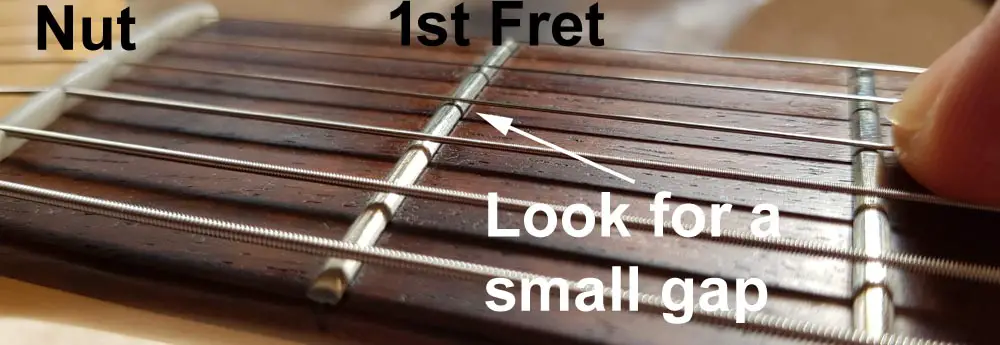
To check, hold each string at the 3rd fret, and check that the string doesn’t touch the 1st fret. If the string is too low then you may need to fill the nut slot, or better still, get a new nut fitted by a guitar tech.
How To Fix Tuning Problems
There are a few things that can cause your guitar to have tuning problems, and many are easy to fix if you know what to look for.
1. Intonation Problems
Intonation refers to how accurately your guitar is playing in tune at each fret.
No guitar on earth has perfect intonation, it’s one of the humanizing aspects of the instrument. However, if it’s way off your guitar is going to sound a bit wacky.
Electric guitars all have adjustable bridges that allow the active part of the string length to be made longer or shorter. When you play a note at the 12th fret, it should ideally still be in tune, and one octave higher than the open string. If not, then the bridge needs adjusting.
This is easy to do, but requires some practice to get it right. Either look up a tutorial, or get a good guitar tech to do this for you.
2. Problems With Tuners
To help with tuning make sure you’re pulling your strings through the tuning pole on the opposite side of the tuning bolt. Then tighten the string by turning it counter-clockwise. This will ensure your stings stay on securely and won’t wear down your tuning poles.
Correct winding of your strings on the posts is essential to keeping constant tuning, and having too many turns around the post can give poor tuning results.
Also, when you tune strings make sure you always tune UP to a note.
If you go above the note you’re aiming for, make sure to tune back down a half step or so, and then begin tuning up again. This will create a tighter bond to the tuning pole and prevent the string from unwinding.
3. String Height Problems
Having your strings too close to your pickups can also affect the way your guitar sounds. The magnetic field of your pickups impacts the way your strings vibrate so the closer your strings are the more they interfere with your sound,
It sounds a bit supernatural but it’s a real issue to watch out for as it can cause your strings to sound out of tune, buzz, and lose sustain.
This is easy to fix, just use a screwdriver to lower your pickups a little.
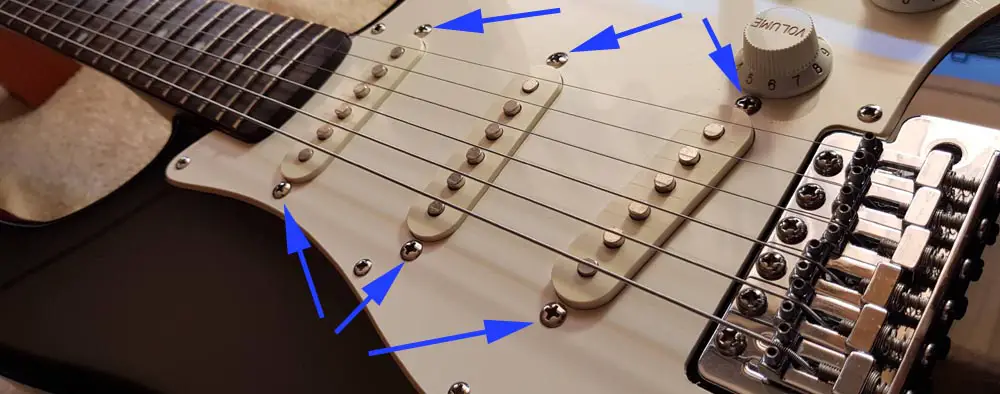
String height at the nut is also very important. If your strings are too high above the lower frets, playing chords and notes there will make the notes sound sharp since you have to bend the string too far down to touch the frets.
If your guitar always sounds out of tune low down the neck, then get a guitar tech to adjust your guitar’s action at the nut.
How To Fix Bending & Tremolo Bar Problems
String binding occurs when the tension of your strings is different on either side of your guitar’s nut. This is caused by the nut slot pinching the string and preventing it from moving smoothly over the nut as you tune.
If the tension on the strings is higher than the tension between the nut and tuning poles this can cause dreaded tuning problems.
Every time you use the tremolo bar and pull your strings, the bound string is tugged on and the loose side of the string gives way. It prevents your string from breaking but immediately puts you out of tune making the use of tremolo unbearable.
If you’re experiencing this issue you need to smooth down the responsible nut slot so that it stops pinching your string, and also lubricate it with some graphite, or guitar nut grease.
If you’re finding your tremolo bar to be too extreme (or not extreme enough) then adjusting the spring tension can help you get it sounding good.
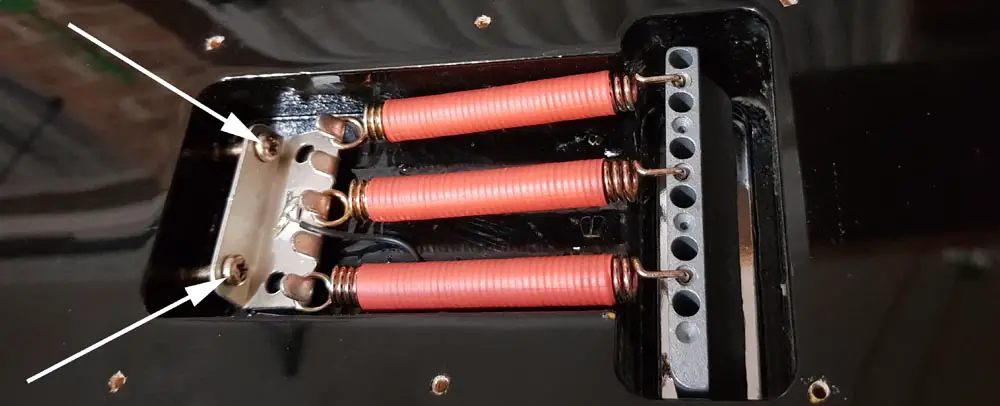
Adjustments to spring tension can be done by adjusting the claw plate on the back of the guitar. Loosening your tremolo arm will help you keep your guitar in tune as the dips of vibrato won’t be as pronounced.
How To Fix Dull Sound
A dull-sounding guitar is usually a result of the strings you’re using. The issue may be that your strings are old and worn out. After a while, strings lose their tone and end up sounding lifeless.
Another issue may be that you’re not using the right type of strings for the sound you’re chasing!
Electric guitar strings tend to fall into two main categories BRIGHT and WARM. Bright strings tend to be more twangy great for genres like indie rock. While warm strings tend to be more rounded on the low end, and are great for metal and rock.
The gauge of your strings can also impact how good your guitar sounds. Thicker strings will always give you a bigger sound than thin strings. Thin strings are attractive for their easy playability but if you go too thin you can diminish your tone.
If you’re finding your tone to be dull and you’re using thin strings; maybe try a gauge thicker next time and see how your guitar sounds.
How To Fix Crackly Amp Noises
Before attempting to clean up your amp, make sure to get some contact cleaner. Using anything with water in it will do far more damage than whatever is causing you issues!
- If you’re having issues with buzzing while playing give your input jacks a good cleanout. Spray some contact cleaner in them and rub around the inside with a cotton bud.
- This is a good time to clean the plug ends of your guitar cables as well. They tend to get left on the floor, so they’re prone to picking up dust. A bit of contact cleaner will also do the trick!
- There’s also the chance that you’re using a broken lead. Issues with guitar leads tend to start off subtle, but that tiny buzz can turn into a tone nightmare. Try using another lead if you have a spare and see if your guitar starts sounding better.
If you’re up for a bit of DIY then cleaning out the electronics inside your amp can alleviate a lot of the crackling noises that might be bothering you.
The contacts and pots on the back of your amps interface can also get caked in with dust and dirt. A good indication that they need a clean is if you hear a crackling noise when you turn the knobs on your amp.
Once again give them a spray down with some contact cleaner and turn the knobs on your amp as you do so.
Final Tips
Here are a few final tips to squeeze better sound from your electric guitar.
Tone Pots
Another area where many cheap guitars can be improved are upgrading the control pots on your guitar – if you’re handy with a soldering iron!
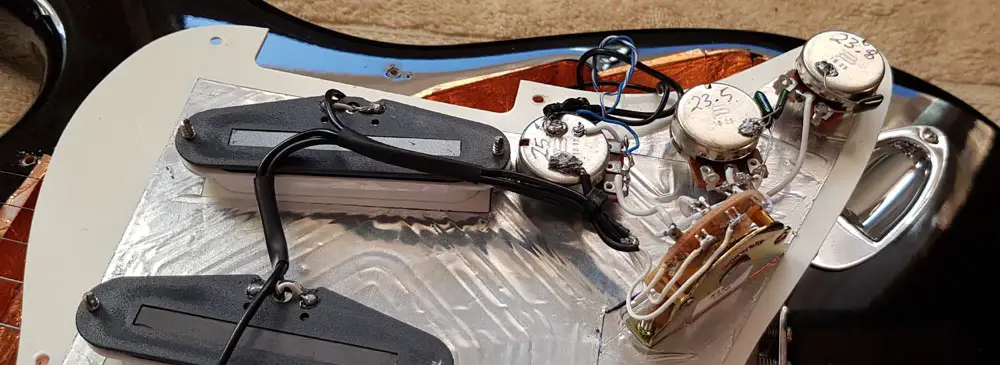
If your tone pots are 500k units, then try changing them for some good quality 250k pots and you’ll find you get more tonal range, and are less likely to make crackly noises when turning them.
Neck Screws
Since you’ve read this far, I’ll reveal a somewhat secret trick that can sometimes make your bolt-on neck electric guitar sound better instantly. This is not a sure-fire thing though, and your results may vary.
Leave your guitar tuned up to normal pitch, and then loosen each neck bolt about 1/8 to 1/4 of a turn. At this point you will often hear a cracking sound, which is your neck shifting tighter into the pocket on the body.
Then tighten the screws again, and tune your guitar. With some guitars this can increase the sustain noticeably, and for such a simple fast to do trick – it’s worth trying!
Nut Material
For a more defined sound and better sustain, if your guitar has a plastic nut, then change it out for a harder material such as bone, Corian, or Tusq©.
Bridge Block
Many cheap guitars come with a cast pot metal block attached to the underside of the bridge. Change this out for a machined brass block, and hear the change in tone.

